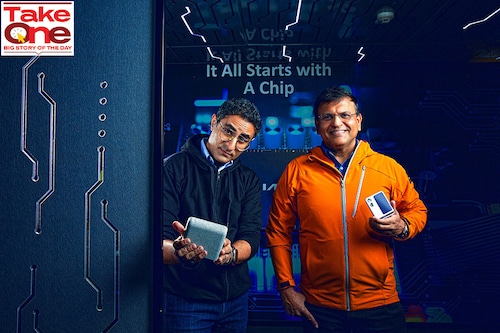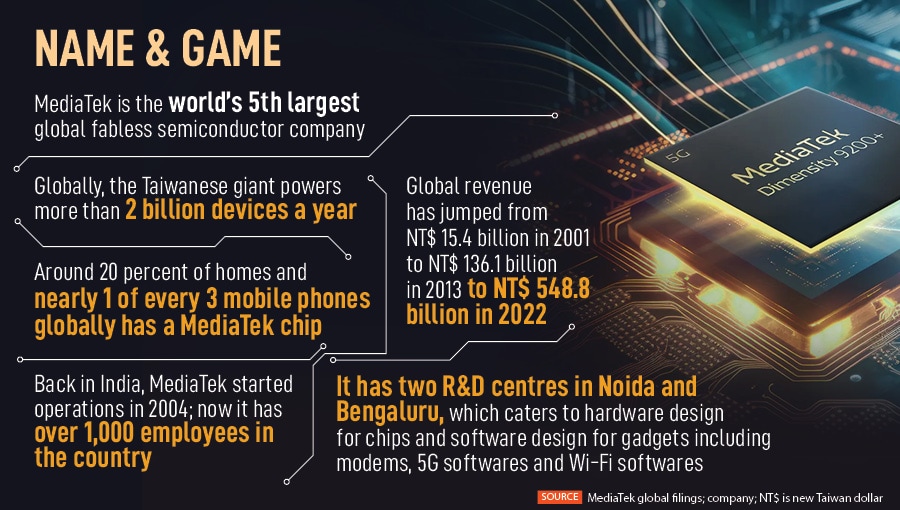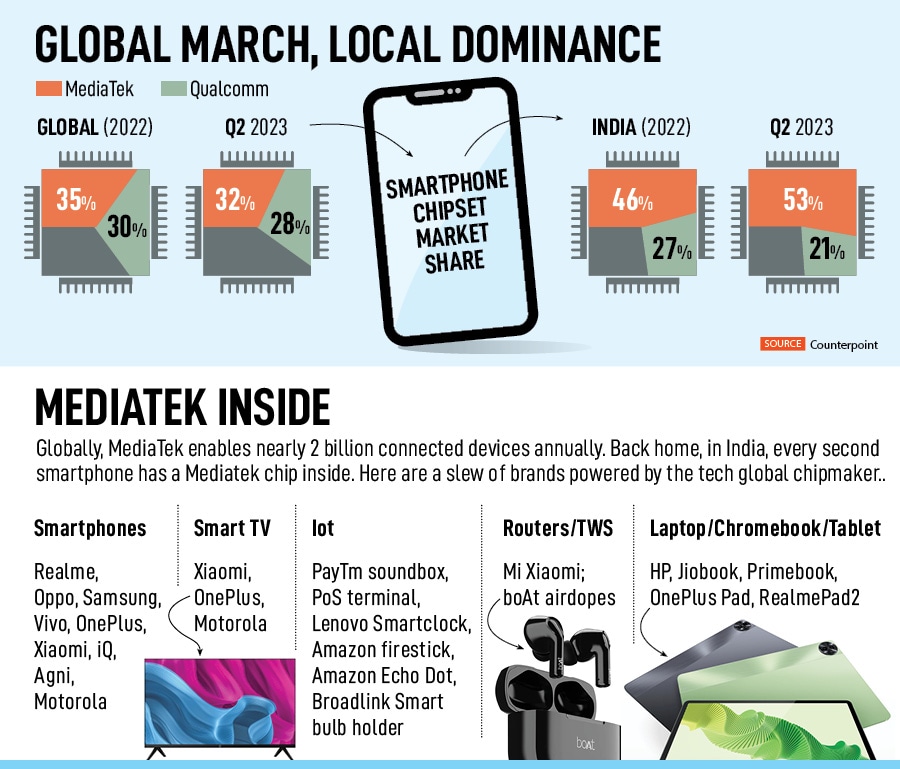MediaTek and a bag of chips
From Alexa to Paytm speaker to TataSky to smartphones and TVs of all top brands, there is an invisible chip powering most of the consumer gadgets. Meet MediaTek, the Taiwanese heavyweight which has be


Sunil Gupta tells us about the ‘visible’ side of the boxed story. “Till 2015, the shopping lingo of a smartphone buyer was confined to just four things," reckons the retailer who has been in the business of selling handsets for over a decade. “Inch, MP, RAM and mAh," he says, listing out the four must-haves sought by the consumers. While inch was all about the size of the screen, MP (megapixel) signified the visual prowess of the camera, RAM (random access memory) gave an idea about the might of the storage, and mAh (MilliAmpere Hours) denoted the power of the battery. “All these were the visible side of the smartphone, and were printed on the box," says Gupta, who has three mobile and consumer electronics’ outlets across Noida and Greater Noida in Uttar Pradesh. Over the next few years, Gorilla Glass, he adds, happened to be the only new spec—and the fifth item—the buyers added to their customary probe list while shopping.
Seven years later, Gupta unboxes the sixth feature—GHz (GigaHertz). “This is the ‘invisible’ side of the smartphone story," he says. With an evolution in the nature of the buyer who has done enough homework and, thus, deep prior knowledge, smartphone makers are giving pride of place to the chip manufacturers in their advertisements as well as consumer communication.
Take, for instance, the commercial of the OnePlus Pad, which highlighted the mouth-watering price tag of Rs 36,999 (which included bank discount offered by ICICI Bank) in one of the full-page print ads. Interestingly, the advertisement didn’t mention any feature of the product except one fact. “Powered by MediaTek Dimensity 9000," it read.

Back in January this year in New Delhi, MediaTek—the world’s fifth largest fabless semiconductor company—was busy conducting its month-long consumer and retailer awareness programme. “MediaTek’s Dimensity 5G family," underlined one of the tech executives conducting the workshop, “includes the 9200, 9000, 8200, 8000, 1000, 900, 800 and 700 series."
Anku Jain, managing director of MediaTek India, intervened to simplify the tech jargon for the attendants. The Dimensity 5G family, he underlined, not only powers the high-end smartphones but brings flagship 5G technology to the mass market so that everyone can experience the power of 5G. “MediaTek brings 5G to devices everywhere—not just smartphones—but PCs, routers, mobile hotspots and more," he added. “With MediaTek Dimensity, you can always expect incredible 5G experiences."

Gupta, interestingly, was busy giving command to Alexa. “Can you turn down the volume," he ordered. “I thought that the chips of MediaTek are only in the smartphones," said Gupta when he was told about how the chips are ubiquitous across a battery of gadgets: From Samsung, Oppo, Vivo and Motorola phones to Paytm speaker and Mi routers to Alexa and firestick to OnePlus and Motorola smart TVs (see box). “It’s incredible," says Gupta.

Jain and Anuj Sidharth tell us about the silent and invisible transformation of MediaTek from a B2B company to a consumer brand. “For long, we stayed invisible and enhanced the quality of lives of the users," says Jain. “Now it"s time to be visible and become a partner in their journey," adds the India managing director of the Taiwanese chipmaker that enables nearly 2 billion connected devices annually. In India, every second smartphone has a Mediatek chip inside, he claims.
Though globally, the Taiwanese major has a slender edge over the American counterpart Qualcomm—while MediaTek had a 32 percent share, Qualcomm cornered 28 percent of the smartphone chipset market in the second quarter of 2023—in India, the gap is substantial. MediaTek has an overwhelming 53 percent share, and Qualcomm has 21 percent, according to the data shared by Counterpoint Research.
Jain, though, is not thinking about the market share. “It’s the consumer and retailer mindshare that we are focusing on," he says. Sidharth, deputy director (marketing) of MediaTek India, chips in to underline the new trajectory in the growth of the media-shy company where brand-building takes the centrestage. The real power of the company, he reckons, is not in powering gadgets of all shapes and kinds. “The real power is when consumers know the chip powering the gadgets," he says.

From consumer and retail outreach to regularly conducting awareness sessions where the focus is to simplify tech jargon and underline how the chips are adding delight to the life of the consumers, MediaTek has been on a consumer overdrive to take the chip out of the box and make it consumer-friendly.
Technology analysts and industry watchers are not surprised with the branding initiatives of MediaTek. Though a bit late in the game of building a brand out of a commodity—Qualcomm’s Snapdragon, in contrast, had a headstart in making consumers aware about the chips inside the smartphones—MediaTek has pressed on the accelerator at the right time. “The turning point for the company came after the Covid," says Tarun Pathak, research director at Counterpoint. From powering the entry-level smartphones, MediaTek jumped a few notches by moving into mid-premium and premium devices," he says. The domination in the Indian market—MediaTek overtook Qualcomm in India in 2020—makes it necessary for the company to make itself visible and reach out to the end users.

MediaTek, reckon marketing and branding experts, is doing an Intel. Before 1991, Intel was the darling of OEMs (original equipment manufacturers) but was largely unknown to the consumers. “In 1991, the chip maker rolled out ‘Intel Inside’ campaign, which made it a household name," says Ashita Aggarwal, professor of marketing at SP Jain Institute of Management and Research. The move was unprecedented. Reason: No tech company had ever showcased ingredient advertising. MediaTek, she points out, has taken a leaf out of Intel’s playbook, and de-jargonised tech. Today, consumers are highly educated and aware about what goes inside every product. From ‘no-cruelty to animal’ labels used by the cosmetic makers to ‘eco-friendly’ ingredients in other products, the users want to have the knowledge of everything. “This helps them in making an informed choice," she says. “That’s why Intel made them aware of what’s driving the laptops, and that’s what Mediatek is doing."
Jain, for his part, is in no mood to scale down the brand awareness campaign. The other high-priority things for the brand, he points out, are to ensure a sharp focus on a seamless 4G to 5G transition, and expanding portfolio for smartphone and smart devices. Recently, the company introduced the Dimensity auto platform for EVs and partnered with NVIDIA to deliver a wide range of in-vehicle AI cabin solutions for the next generation of software-defined vehicles. “Industries understand technology, and consumers understand stories," he says. “Our job is to make technology simple and take it to the masses," he signs off.
First Published: Oct 04, 2023, 13:48
Subscribe Now